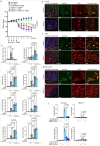This is a preprint.
PGLYRP-1 mediated intracellular peptidoglycan detection promotes mucosal protection
- PMID: 39483916
- PMCID: PMC11527351
- DOI: 10.21203/rs.3.rs-5118704/v1
PGLYRP-1 mediated intracellular peptidoglycan detection promotes mucosal protection
Update in
-
PGLYRP1-mediated intracellular peptidoglycan detection promotes intestinal mucosal protection.Nat Commun. 2025 Feb 21;16(1):1864. doi: 10.1038/s41467-025-57126-9. Nat Commun. 2025. PMID: 39984444 Free PMC article.
Abstract
Peptidoglycan recognition proteins (PGRPs or PGLYRPs) are implicated in the control of the intestinal microbiota; however, molecular requirements for peptidoglycan (PGN) binding and receptor signaling mechanisms remain poorly understood. We identified PGLYRP-1 as a receptor for the disaccharide motif of lysine N-acetylglucosamine N-acetylmuramic tripeptide (GMTriP-K) with a newly constructed PGN microarray. Surprisingly, PGLYRP-1 was required for innate immune activation of macrophages by GMTriP-K but not N-acetylglucosamine N-acetylmuramic dipeptide (GMDiP) or muramyl dipeptide (MDP). In macrophages, intracellular PGLYRP-1 complexed with NOD2 and GEF-H1, both of which were required for GMTriP-K-regulated gene expression. PGLYRP-1 localized to the endoplasmic reticulum and interacted at the Golgi with NOD2 upon GMTriP-K stimulation. PGLYRP-1 upregulation and its dependent gene expression signatures were induced in both mouse intestinal inflammation and human ulcerative colitis. Importantly, PGLYRP-1 activation by GMTriP-K resulted in innate immune activation and protection of mice from colitis. Our results show that PGLYRPs can function as intracellular PGN pattern recognition receptors for the control of host defense responses in the intestine.
Conflict of interest statement
Competing interests None
Figures






References
-
- Dziarski R., Platt K. A., Gelius E., Steiner H. & Gupta D. Defect in neutrophil killing and increased susceptibility to infection with nonpathogenic gram-positive bacteria in peptidoglycan recognition protein-S (PGRP-S)-deficient mice. Blood 102, 689–697, doi:10.1182/blood-2002-12-3853 (2003). - DOI - PubMed
Publication types
Grants and funding
LinkOut - more resources
Full Text Sources

